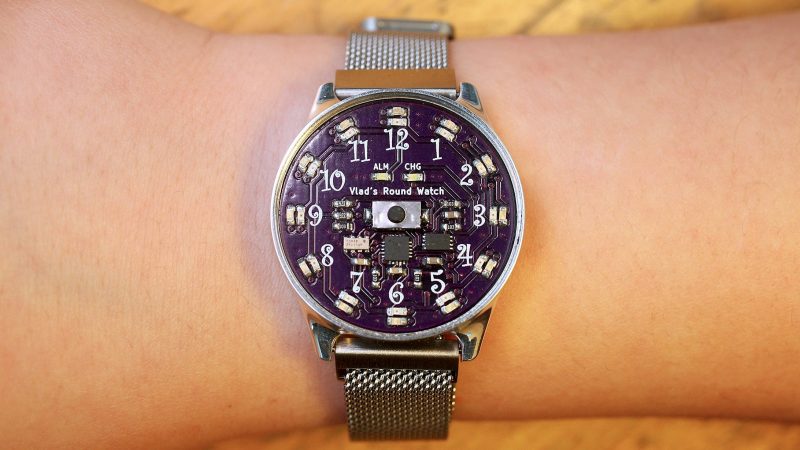Sporting a new wristwatch to school for the first time is a great moment in a kid’s life. When it’s a custom digital-analog watch made by your dad, it’s another thing altogether.
As [Chris O’Riley] relates, the watch he built for his son [Vlad] started out as a simple timer for daily toothbrushing, a chore to which any busy lad pays short shrift unless given the proper incentive. That morphed into an idea for a general purpose analog timepiece with LEDs taking the place of hands. [Chris] decided that five-minute resolution was enough for a nine-year-old, which greatly reduced the number of LEDs needed. An ATtiny841 tells a 28-channel I2C driver which LEDs to light up, and an RTC chip keeps [Vlad] on schedule. The beautiful PCB lives inside a CNC machined aluminum case; we actually commented to [Chris] that the acrylic prototype looked great by itself, but [Vlad] wanted metal. The watch has no external buttons; rather, the slightly flexible polycarbonate crystal bears against a PCB-mounted pushbutton to control functions.
With a snappy wristband, [Vlad] will be rolling fancy on the schoolyard. It’s a great looking piece that needed a wide range of skills to execute, as all watches do. Check out some other watch builds, like this lovely pure analog, another digital-analog hybrid, or this pocket watch that packs an Enigma machine inside.















Nice!
If he’d turn two LEDs on at once when the time is closest to 2.5minutes between the 5 minutes, he could be accurate to 2.5 minutes.
EG,
12:00, just the 12 LED
12:01:26, turn on the 12 and 1 LEDs,
12:03:76 turn on the 1 LED
What kind of minutes do you have in your part of the world? The 100 seconds ones? :-)
Maybe he’s from Newfoundland…
B^)
Derp. Who the hell thought of a base 60 time scale anyway? :p
You get the idea.
at 12:00:00 the 12LED is on
at 12:01:16 LED 1 also turns on
at 12:03:46 12 LED turns off
:)
Thanks, and that’s a great suggestion! What I like so much about making things around microcontrollers is that you can reprogram them at any time to change or add features. Since the LED driver can PWM each individual LED, I could even change the brightness of the adjacent LEDs to approximate where the actual time is between the two. So 2.5 minutes between, they’d be the same brightness, 30 seconds after or before a 5 minute mark, the nearest LED would be noticeable brighter than the other.
The code is still in progress, there’s a few things I’m going to change or have yet to implement. I’ll add that to the list!
an altenative idea: just let the light of the minute led hold for 200ms(time for the eye to focus), then let it go dimm and light it again (with pwm fading) in a 50 -100 ms cycle for each minute above the led position. he will get used to it very fast. Removes the problem with comparing brightness, and he doesnt have to count, your brain will do this for you within a few days.
Going off that idea, you could blink the minute LED the number of minutes after that mark.
So 8:34 = 8LED On, then 6LED On followed by 4 blinks.
8:30 the 6LED would just stay on.
Love the ideas guys. The blinking minute like would definitely be clearer than comparing brightness. Good thing I made the watch round, because when it no longer rounds the time, it wouldn’t make sense to call it the Round Watch! ;)
Looks like you need to try them all to see which looks best, or let Vlad decide!
I bet the the “blinks for minutes past the 5 minute mark” that Dr. Von Blinkenthings suggested would probably be the clearest with the most precision.
You could also just gradually fade up to the 5 minute mark that the time was approaching. That would keep it “analog” like the ratio mode would.
So many options with LEDs and PWM.
How about a “Larson Scanner” mode?